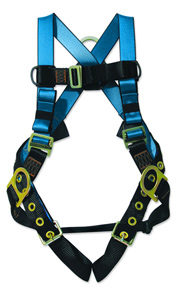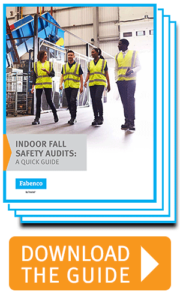
From heavy equipment to dust, gas, liquid metal, noise, heat, chemicals, and working at heights, steel manufacturing employees face a variety of health and safety risks every day. While a wide range of safety precautions are essential, including the use of a fall safety harness and safety lanyards, industrial swing gates, and more, it’s even more important to cultivate a culture of safety throughout the entire organization. Not only will it help reduce your risk of OSHA fines and legal issues, it’ll improve productivity, reduce downtime, and, above all, protect your workers.
Take these steps to create a culture of safety in steel manufacturing:
Insist Upon Appropriate Safety Gear

According to OSHA, to prevent employees from being injured from falls, employers must:
- Guard every floor hole into which a worker can accidentally walk (using a railing and toe-board or a floor hole cover).
- Provide a guardrail and toe-board around every elevated open sided platform, floor or runway.
- Regardless of height, if a worker can fall into or onto dangerous machines or equipment (such as a vat of acid or a conveyor belt) employers must provide guardrails and toe-boards to prevent workers from falling and getting injured.
- Other means of fall protection that may be required on certain jobs include a fall safety harness and safety lanyard, safety nets, stair railings, hand rails, and indoor safety gates.
Of course, there’s other hazards besides falls. Respirators, head, face, and eye protection, gloves, and more may be necessary. All employees should be trained in the proper use of their personal protective equipment, including their goggles, gloves, safety lanyards and other equipment, and they should be taught and expected to inspect it before every use. When it comes to creating a culture of safety, this is one of the most basic actions you can take. Employees feel valued when you demonstrate that their safety is a priority above production. Providing the right PPE (and the right training to use and inspect it) shows that safety comes down from the top.
Furthermore, OSHA requires employers to provide PPE.
Perform Self-Audits
As time goes on, it’s possible your employees and managers will grow lax or complacent—especially if, historically, their accident record is spotless. When nothing bad has happened, it’s easy to neglect putting on PPE for one quick task, or to disregard things like missing or broken indoor safety gates. But, of course, no one ever plans on having an accident, which is precisely why, spotless record or not, you need to audit your workplace on a regular basis. Here’s a few things to consider:
- Do you have fall protection in place where necessary?
- Are your industrial swing gates in working order, and do you have one everywhere you need one?
- Do you have PPE that fits each employee properly?
- Have you met every OSHA requirement and gone above and beyond to ensure no one gets hurt in your facility?
- Do employees know, understand, and follow all protocols?
- Does everyone know what to do in an emergency?
- Is your safety log accurate and up-to-date?
Maintaining this kind of on-going diligence is a pillar of safety culture.
Conduct Regular Safety Training
On top of audits, staying up-to-date on the best safety practices and equipment also contributes to a culture of safety. New employees should go through training on each piece of equipment they work with, as well as the safety procedures for the entire facility. Long-time employees should participate in periodic refresher courses and any new equipment should come with its own training program.
Safety training should not only talk about the “how”, but also the “why”. Take a look at the types of injuries that can occur when safety protocols aren’t followed—cuts and abrasions when failing to wear gloves, eye injuries when failing to use eye and face protection, amputations without proper machine guarding, fall-related injuries when failing to use indoor safety gates. When employees understand why they’re doing something, they’re more likely to do it.
Put Employees First
Your people are your first priority, before productivity and profits. Workers should feel empowered to speak up if they see a safety hazard. There should be no expectation that they keep working in the absence of the appropriate safety measures.
Reward Safety
Employees want to be recognized for a job well done. That appreciation goes a long way in building loyalty, morale, and employee satisfaction, and it doesn’t always have to center around productivity. In fact, rewarding productivity above all else is part of what can lead to reduced attention to safety.
However, creating a rewards program around safety can be tricky. Rewarding number of days without injury, for example, can lead to under-reporting of injuries, which does nothing to improve safety and actually puts employees at greater risk. Furthermore, going home safe is its own reward, so any rewards system you create should be carefully implemented and observed over time to ensure it’s having the effect you want. Instead of a formal program, you may simply decide as managers to make sure you thank and recognize the people who identify safety hazards and encourage safety practices among their co-workers.
Value Safety at All Levels
Installing the necessary indoor safety gates and railings, using safety lanyards and a fall safety harness, and insisting on safety training is only the beginning of building a culture of safety in steel manufacturing. Every member of the organization has to value safety, and that goes all the way to the top, where owners and managers are watching the bottom line. They need to be willing to put employee safety first, and make it known that is their top priority.
Failing to do so will cost the company in the long run, perhaps in terms of fines for non-compliance, lawsuits, and injuries that result in missed work days, lowered morale, and lack of trust in company leadership. Everyone is affected by a workplace injury. Those who witness the incident may have trouble returning to work, and the fear and distraction could lead to additional accidents. It’s hard to tell where the ramifications end—and all because of something that could have been prevented in the first place.
When it comes to safety equipment, you don’t have to guess: at Fabenco, we supply only OSHA-compliant industrial swing gates, harnesses, lifelines, and more. For nearly 50 years, we’ve been offering high-quality, American-made safety equipment to help you keep your employees safe and develop the culture of safety your team needs. Contact us for more information and any questions you have about workplace safety.





